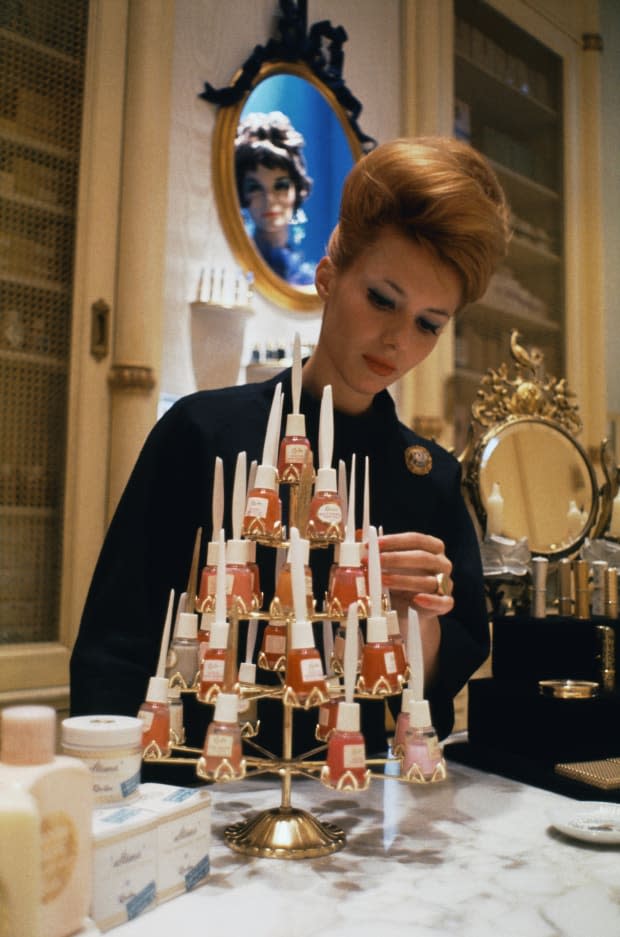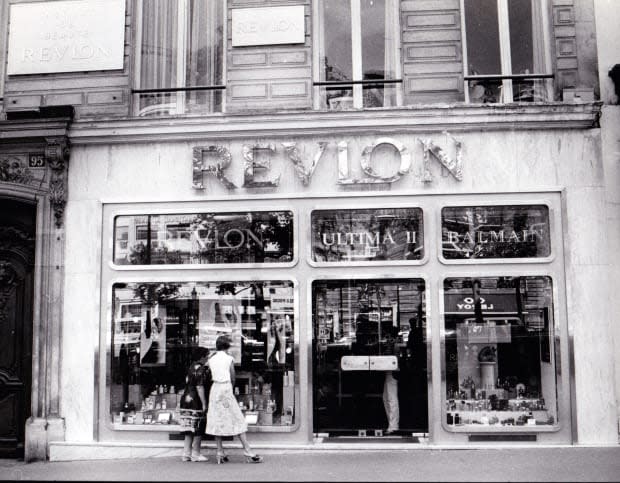In the TikTok Era, Which Drugstore Beauty Brands Will Survive?
In the wake of Revlon's bankruptcy filing and amid a new digital era, there are (at least) two factors that ensure mass-market success.
In 1932, Revlon launched the very first red nail varnish — at least, the very first red nail varnish to be made available commercially in the United States. It was conspicuous, sultry and classically chic, one small way for women to dote upon themselves in the midst of the Great Depression.
By the 1940s, the company introduced lipsticks, with fragrance arriving a decade later. Its campaigns were provocative, often casting a femme fatale archetype that, in heterosexual gender theory, emboldened women and aroused men. It was a new way to not just create makeup, but also to sell it, setting a precedent for the industry to follow for generations to come.
Until it didn't. In June, Revlon filed for Chapter 11 bankruptcy protection, crushed by its reported $3.3 billion in long-term debt and plunging revenue; its sales of about $1.9 billion in 2020 were down 21% from 2019 levels. This, analysts suggested, owed to a lack of innovation in at least two areas — 1) its products, and 2) its marketing — that helped establish the cosmetics giant in the first place, nearly a century earlier.
How did Revlon, one of the most iconic brands in the American drugstore aisle, lose its grip? In our post-analog TikTok era, it's easier than you might think. And yet, it's also a formidable time for mass cosmetics retailers to compete with social-media-beloved challengers — as long as they're doing something worthy of the competition.
"You can't sell a beauty product strictly on names alone," says Kirbie Johnson, a beauty reporter and co-founder of beauty podcast Gloss Angeles. "There has to be some type of innovation, something that separates the brand from everything else on the market."
When brothers Charles and Joseph Revson founded Revlon in New York City, there was, obviously, far less market competition. By the end of World War II, Revlon was the number-two cosmetics producer in the U.S. Come the 1960s, it was time to diversify, with the Revson brothers segmenting Revlon, Inc. into different divisions, each with its own target customer. By the end of the 1970s, Revlon, Inc. had a stake in categories ranging from antacids to eye care. But in the mid-1980s, the company started slipping, losing ground to peers like Estée Lauder and CoverGirl.
On Nov. 5, 1985, billionaire businessman Ron Perelman bought the company in a hostile takeover. But this wasn't a silver-bullet solution, either. Instead, it saddled Revlon with $2.9 billion in debt, making the company particularly vulnerable to rocky market dynamics to this day. Once the pandemic hit in 2020, with global demand for cosmetics sputtering, the makeup sector as a whole found itself on treacherous waters, Revlon among them. Between March and April of 2020, the U.S. prestige beauty market saw a year-over-year sector decline of $1.4 billion, according to data from market research group NPD.
"With a legacy brand like Revlon, it's somewhat surprising it'd file for bankruptcy given it's been a constant in the beauty space," says Johnson. "It'd be bizarre to see a beauty aisle without them. But a strong brand doesn't equal an economically sound company."

Photo: Bettmann/Contributor
It could perhaps be argued, Johnson adds, that if Perelman wasn't given billions of dollars in loans, the company wouldn't be in this position in the first place. But the debt alone wasn't to blame. Elyse, a TikTok creator who asked that Fashionista not publish her last name for the purpose of anonymity, speculates that Revlon's woes ran wider, all across its holdings.
"People say the company you keep is important, and I wonder if that hindered Revlon's success," says Elyse, who posts about the history of beauty from the handle @atlasofyouth. "Some brands under Revlon's portfolio include Elizabeth Arden, Almay and Cutex, all of which are outdated. Perhaps being surrounded by brands with lack of innovation and outdated marketing practices contributed to Revlon's demise."
Let's take the first factor — a lack of innovation in product development. Today, the global beauty industry is a $532-billion business, with projections that it will continue to advance at a 5%-to-7% compound annual growth rate to reach or exceed $800 billion by 2025. For mass beauty brands, those numbers don't lie: There's too much competition, fed by blooming consumer demand, to stay stagnant. In other words, evolve or, well, die.
For Johnson, Revlon started showing signs of distress when it was no longer adapting to the marketplace, launching novel products like its competitors. She offers the example of the carved-out Instagram brow of 2017, when Revlon did, in fact, partner with select influencers and celebrities in the space, like Gigi Gorgeous and Kandee Johnson. But as Johnson warns, relevance — in this case, by way of ambassadorships — is not innovation.
So what is? In 2017, the same year Revlon was collaborating with YouTube-famous makeup artists, Rihanna's Fenty Beauty was busy launching its first-of-its-kind 40-shade foundation range. Now, Fenty Beauty may not be a mass cosmetics brand at Revlon's scale, but that didn't matter because soon, major retailers raced to release more inclusive shades as a response.
That did include Revlon, as it turned out. In 2018, the retailer debuted Flesh, a prestige, inclusivity-led line positioned to take on Fenty with 40 foundation shades. The launch was hotly anticipated, with analysts anticipating that Flesh could deliver $40-50 million in sales in its first year, per Vogue Business. In reality, sales reportedly fell closer to the single-digit-millions range, and by May 2020, Ulta, its exclusive retail partner, dropped Flesh altogether.
View the original article to see embedded media.
How can a mass-market beauty brand like Revlon put a proper stake in the ground and create an industry-shattering innovation of its own? According to former L'Oréal product manager Vivian Lynn, a marketing professional and TikTok creator in the beauty and technology spaces, the first step is to look introspectively. Think about your own strengths. How can you double down on them? Consider the humble, drugstore skin-care brand CeraVe, which, despite launching in the U.S. way back when in 2005, went viral on TikTok only just last year. To date, the "#cerave" hashtag clocks in at 2.5 billion views.
"Before CeraVe was on TikTok, it was focusing on doubling down on its strengths, which is accessibility in price and distribution channel," says Lynn, who joined L'Oréal with a background in biochemistry. "It was working with historically unglamorous key opinion leaders, like dermatologists. Its distribution channel was the drugstore. It wasn't looking to be cool."
But in the end, it were these strengths that made CeraVe TikTok's favorite skin-care brand. TikTok loves CeraVe for how readily accessible it is. But if CeraVe hadn't already spent years working to maintain that low price and availability, this would read much differently.
Which brings us to the second factor in Revlon's collapse: a lack of innovation in marketing. First is the physical component, which Johnson argues could stand something of makeover.
"Innovation is king," she says, "but I've learned that how people buy product and become loyal is that they want to see themselves in the products they buy, or at least like what they're purchasing — enough to display it or put it in their purse. With Revlon, I'd lean into the fact it's been around since 1932 and create packaging that has a bit more vintage flair."
From there, the social media component should be easy, at least in theory. As Elyse notes, many drugstore brands are a part of giant beauty conglomerates that have a leg up with their marketing and creative budgets. Not only do they have large teams, she says, but they also have the ability to shell out for knockout digital departments across advertising, e-commerce and of course, social media.
"Brands need to be obsessed with listening to their consumer," says Lynn. "The landscape changes microscopically every day with different trends, and macroscopically with different tech innovations. It's all about prioritizing what's micro and what's macro. Trends will come and go, so it's just about determining, with consumer data, what's here to stay."

Photo: Images/Getty Images
One such success story is that of E.l.f. Cosmetics, an 18-year-old digital native out of Oakland that initially made a name for itself with its affordable drugstore makeup and skin-care products. E.l.f. hasn't been without its falters: In 2019, it closed all 22 of its brick-and-mortar locations and began its hunt for a new president and CFO. But then it hit TikTok, and the platform dubbed several of its products more accessible "dupes" for pricier, cult-favorite alternatives. Johnson, for one, isn't surprised by its success.
"It makes excellent products for an affordable price, but it also puts out products people want without going too hard into trend-driven products that phase out," she says. "It was one of the first brands to go all-in on TikTok."
Even across a crowded platform, Revlon is no stranger to TikTok, with two launches in particular generating the type of social media attention you can't pay for: the first being its One-Step Hair Dryer, and the second its Oil-Absorbing Volcanic Roller. A single tutorial of the former, posted just this past January, has generated 21.7 million views alone.
"These products were affordable innovations that people wanted to pick up because they saw it worked for others," says Johnson. "This all could be a moot point, though. The expansive debt Revlon accrued may have made it difficult for them to ever get a leg up, even if it was going viral every other week."
In filing for Chapter 11 bankruptcy, Revlon is seeking the opportunity to restructure its obligations to creditors, all while staying in business. It's not exactly a get-out-of-jail-free card, but it is a shot at a clean slate. Because if Revlon pulls through to the other side, it could be set up for success — as long as the market stays favorable, that is. (And that part could be tricky, as experts widely predict a global recession on the horizon.)
In today's TikTok era, drugstore brands are worthy competitors with direct-to-consumer players now scrambling to find their way into mass retailers as part of a two-lane strategy. Glossier, for one, made its first move into a wholesale retailer with Sephora, while Colourpop is now available at Ulta. And as Johnson explains, mass brands often have an easier point of entry because they're available at places like Wal-Mart, Target, CVS and Walgreens, which have built out brightly-lit beauty sections that feel like a separate shopping experience.
If anything, the current day and age may help replicate Revlon's initial centuries-old success: Amid an economic downturn and social upheaval, the brand found itself selling cosmetics, and thriving while doing it. Economists may attribute this to what they call the "Lipstick Index," a theory that, when facing an economic crisis, consumers will be more willing to spend money on small indulgences over big-ticket ones. With the current economic climate, it may just be the perfect time for drugstore brands (particularly those not ridden with unmanageable debt) to shine. They should just make sure innovation takes a front seat.
Never miss the latest fashion industry news. Sign up for the Fashionista daily newsletter.